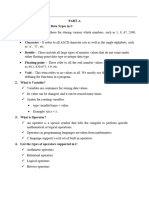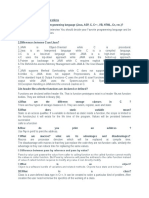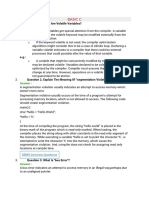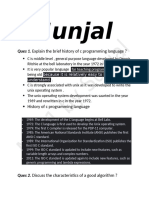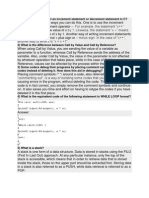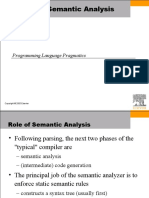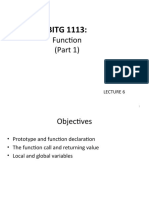TPL 6 Chapter (Short Answers) : Use Postfix Notation Two Programming Languages
TPL 6 Chapter (Short Answers) : Use Postfix Notation Two Programming Languages
Uploaded by
sania ejazCopyright:
Available Formats
TPL 6 Chapter (Short Answers) : Use Postfix Notation Two Programming Languages
TPL 6 Chapter (Short Answers) : Use Postfix Notation Two Programming Languages
Uploaded by
sania ejazOriginal Title
Copyright
Available Formats
Share this document
Did you find this document useful?
Is this content inappropriate?
Copyright:
Available Formats
TPL 6 Chapter (Short Answers) : Use Postfix Notation Two Programming Languages
TPL 6 Chapter (Short Answers) : Use Postfix Notation Two Programming Languages
Uploaded by
sania ejazCopyright:
Available Formats
TPL 6th Chapter (Short Answers)
1. Name eight major categories of control-flow mechanisms
Name eight major categories of control-flow mechanisms. Selection, iteration,
procedural abstraction, recursion, concurrency, exception handling, speculation,
nondeterminacy.
2.What distinguishes operators from other sorts of functions?
Function calls usually consist of function name followed by a parenthsized, comma-
separated list of arguments. Operators are typically simpler taking only one or two
arguments without parens or commas.
3. Explain the difference between prefix, infix, and postfix notation. What is
Cambridge Polish notation? Name two programming languages that use
postfix notation?
In the infix expressions, it is difficult to keep track of the operator precedence whereas
here the postfix expression itself determines the precedence of operators (which is
done by the placement of operators)i.e the operator which occurs first operates on the
operand. The main difference between prefix and postfix is that the prefix is
a notation that writes the operator before operands while the postfix is a notation that
writes the operator after the operands. Notation is the way of writing arithmetic
expressions.
Cambridge Polish notation allows. operators to have a variable number of operands
or. scope, but requires that the operator and all of its. operands be enclosed in a pair of
parentheses. Logic languages are based on predicate logic. A few language use
postfix notation and finally here it is being evaluated in two programming languages:
Scheme (Racket) and Postscript (Ghostscript).
4.Why don’t issues of associativity and precedence arise in Postscript or
Forth?
Postscript and Forth use postfix notation. Smalltalk ... C has so many rules
for precedence and associativity that most programmers don't know them all then an
overflow can occur if b+d doesn't fit in an integer.Hence, this makes for problems.
5.What does it mean for an expression to be referentially transparent?
An expression is called referentially transparent if it can be replaced with its
corresponding value (and vice-versa) without changing the program's behavior. This
requires that the expression be pure, that is to say the expression value must be the
same for the same inputs and its evaluation must have no side effects.
6. What is the difference between a value model of variables and a reference
model of variables? Why is the distinction important?
A Value Type holds the data within its own memory allocation and a Reference Type
contains a pointer to another memory location that holds the real
data. Reference Type variables are stored in the heap
while Value Type variables are stored in the stack.
7. What is an l-value? An r-value?
L-Value: Left hand side of assignment indicating the location of change. Usually variables to
parts of variables.
R-Value: Right hand side of assignment that provides the new value. Usually the result of
evaluation and expressions.
8. Why is the distinction between mutable and immutable values
important in the implementation of a language with a reference model of
variables?
Mutable values can cause multiple variables referring the values to change which can cause
issues.
9. Define orthogonality in the context of programming language design?
Orthogonality in a programming language means that a relatively small set of
primitive constructs can be combined in a relatively small number of ways to build the
control and data structures of the language. It is associated with simplicity; the
more orthogonal the design, the fewer exceptions.
10. What does it mean for a language to be expression-oriented?
An expression-oriented programming language is a programming language where
every (or nearly every) construction is an expression and thus yields a value. ...
Some expression-oriented languages introduce a void return type to be yielded
by expressions that merely cause side-effects.
11. What are the advantages of updating a variable with an assignment
operator, rather than with a regular assignment in which the variable
appears on both the left- and right-hand sides?
12.Given the ability to assign a value into a variable, why is it useful to be
able to specify an initial value?
One downside of assignment is that it requires at least two statements:
One to define the variable, and one to assign the value.
These two steps can be combined. When a variable is defined, you can also provide an
initial value for the variable at the same time. This is called initialization.
C++ supports three basic ways to initialize a variable. First, we can do copy
initialization by using an equals sign:
1 int width = 5; // copy initialization of value 5 into variable width
13.What are aggregates? Why are they useful?
In general, an aggregate is data composed of smaller pieces that form a larger
whole. In programming, aggregation is a type of object composition where not all
the containing objects should be destroyed when the owning object is destroyed.
14. Explain the notion of definite assignment in Java and C#.
At any point a variable is used, Java and C# first check to see if there was an assignment to it. If there is
any point in the code where it is possible a variable is not used, it will not even compile.
E.g.
int i;
int j=5;
if(j > 0)
i=2;
else
print i; //I was never initialized to anything;
compiler will complain
15. Why is it generally expensive to catch all uses of uninitialized variables at
run time?
All computers stores bits in their variables, it is up to us as programmers to give the bits
meaning. A computer does not know if we want to use uninitialized space; uninitialized still
means it has a particular order of bits.
In order to recognize a variable as uninitialized, it must somehow keep track of when a
variable is un/initialized, as well as what are “good” verses “bad” values. This adds extra
memory constraints and computations .
17. Why do most languages leave unspecified the order in which the
arguments of an operator or function are evaluated?
So the code can be generated at compile time for the loop control. The size of the loop is
known , so step-size needs to be available at compile time as well.
18. What is short-circuit Boolean evaluation? Why is it useful?
A compiler that performs short-circuit evaluation of Boolean expressions will generate code
that skips the second half of both of these computations when the overall values can be
determined from the first half. Short-circuit evaluation can save significant amounts of time in
certain situations .
19. List the principal uses of goto, and the structured alternatives to each.
It performs a one-way transfer of control to another line of code; in contrast a function call
normally returns control.
Most modern languages provide an explicit return statement. Where once a goto might have
been used to escape from the middle of a loop , most modern languages provide a break or
exit. More significantly, several languages allow a program to return form a nested chain of
subroutine calls in a single operation that propagates out to some surrounding context s.
20. Explain the distinction between exceptions and multilevel returns.
Both transfer control from inner to outer context and unwind the stack.
In multilevel return, the inner context completes computation and transfers control in a way
that needs no post-processing.
An exception cannot complete its work in the inner context, so the handler in the outer
context must be executed.
21. What are continuations? What other language features do they subsume?
It consists of code address and a referencing environment to be rested when jumping to that
address.
A continuation is an abstraction that captures a context in which execution might continue.
22. Why is sequencing a comparatively unimportant form of control flow in
Lisp?
In common Lisp, the programmer can choose to return the value of the first element, the
second, or the last. Of course, sequencing is a useless operation un less the sub-expressions
that do not play a part in the return value have side effects.
23. Explain why it may sometimes be useful for a function to have side effects.
There are some situations in which side effects in functions are highly desirable. We saw one
example in the label name function. Another arises in the typical interface to a pseudorandom
number generator:
Obviously rand needs to have a side effect, so that it will return a different value each time it is
called. One could always recast it as a procedure with a reference parameter.
24. Describe the jump code implementation of the short-circuit Boolean
evaluation.
In Jump Code inherited attributes of the root of the syntax tree inform it of the address to
which control should branch if the expression is true or false, respectively. Jump code can be
generated quite elegantly by an attribute grammar, particularly on that is not L-attributed.
25. Why do imperative languages commonly provide a case statement in
addition to if... then ... else?
26. Describe three different search strategies that might be employed in the
implementation of a case statement, and the circumstances in which each
would be desirable.
Sequential testing, Hashing, and binary search.
Sequential testing (as in an if… then … else statement) is the method of choice if the total
number of case statement labels is small. It runs in time O(n), where n is the number of labels.
A hash table is attractive if the range of label values is large, but has many missing values and
no large ranges. With an appropriate hash function it will run in time O(1). Unfortunately, A
hash table requires separate entry for each possible value of the tested expression, making with
large value range.
Binary search can accommodate ranges easily . It runs in time O(log n), With a relatively low
constant factor
27. Describe three subtleties in the implementation of enumeration-
controlled loops.
Executed once for every value in a given finite set. Number of iterations is known before first
iteration begins.
28. Why do most languages not allow the bounds or increment of an
enumerationcontrolled loop to be floating-point numbers?
Because of numerical imprecision.
29. Why do many languages require the step size of an enumeration-
controlled loop to be a compile-time constant?
So the code can be generated at compile time for the loop control. The size of the loop is
known, so step-size needs to be available at compile time as well.
30. Describe the “iteration count” loop implementation. What problem(s) does
it solve?
Iteration count involve pre-computing the number of iterations that will take place in the loop
based on the step, and then decrementing this number.
Removes the problem of determining the sign of the step and figuring out how to implement it.
This is precomputed.
31. What are the advantages of making an index variable local to the loop it
controls?
32. Does C have enumeration-controlled loops? Explain.
C, C++,Java do not have enumeration controlled loops although the logically controlled for
statement can be used to create n enumeration- controlled loop:
33. What is a container (a collection)?
A container or collection is a set of well- defined objects of finite length.
34. Explain the difference between true iterators and iterator objects.
True iterators represents a subroutine that is permitted to contain yield statements, each of
which produces loop index value.
An iterator is a separate thread of control with its own program counter.
35. Cite two advantages of iterator objects over the use of programming
conventions in a language like C.
No yield statement and no separate thread-like context to enumerate values. Ordinary objects
that provides methods for initialization, generation of next index value , and texting for
completion.
You might also like
- Citect SCADA - Compile Error MessagesDocument13 pagesCitect SCADA - Compile Error Messagesconnect.rohit85No ratings yet
- QuestionsDocument12 pagesQuestionsVenkatramana ReddicherlaNo ratings yet
- Jaz CDocument6 pagesJaz Cmusharafmd696No ratings yet
- TCS Technical Interview Questions and AnsDocument23 pagesTCS Technical Interview Questions and AnsTheja ReddyNo ratings yet
- C Programming short QNADocument9 pagesC Programming short QNAsadabjaowad69No ratings yet
- Yuva CDocument7 pagesYuva CGloriya Priyadarshini CSNo ratings yet
- C Study GuideDocument10 pagesC Study Guidechandra.sroNo ratings yet
- Linux Commands PracticalDocument26 pagesLinux Commands PracticalRavi VermaNo ratings yet
- Done PDFDocument10 pagesDone PDFNishad BankarNo ratings yet
- PYQ with Solution-2Document11 pagesPYQ with Solution-2reshantgarg0No ratings yet
- Cs2311-Object Oriented ProgrammingDocument22 pagesCs2311-Object Oriented Programmingbalakrishnan gNo ratings yet
- CPDS Unit 1 QBDocument6 pagesCPDS Unit 1 QBkirubaNo ratings yet
- How Do You Determine Whether A Loop Ended PrematurelyDocument4 pagesHow Do You Determine Whether A Loop Ended PrematurelyLakshmi PrabhaNo ratings yet
- Tcs QuestionsDocument12 pagesTcs QuestionsKajol MathuriaNo ratings yet
- Collection of Technical Interview QuestionsDocument163 pagesCollection of Technical Interview QuestionsAkhil Akhi100% (1)
- Papers/electronics-Communication-Engineering-Ece/33133052: 25 Best Embedded Systems Interview Questions and AnswersDocument4 pagesPapers/electronics-Communication-Engineering-Ece/33133052: 25 Best Embedded Systems Interview Questions and Answerschidvilas bNo ratings yet
- FP UNIT 5 SwiftDocument4 pagesFP UNIT 5 SwiftDimple GullaNo ratings yet
- TCS Technical Interview QuestionsDocument15 pagesTCS Technical Interview Questionsraj kumarNo ratings yet
- Point To Remember: TCS Technical Interview Questions ASP, C, C++, VB, HTML, C#, Etc.) ?Document21 pagesPoint To Remember: TCS Technical Interview Questions ASP, C, C++, VB, HTML, C#, Etc.) ?aakash reddyNo ratings yet
- C - Interview Questions: Q1.Define The Scope of Static VariablesDocument6 pagesC - Interview Questions: Q1.Define The Scope of Static VariablesAnshuman KrishnakumarNo ratings yet
- Point To Remember: Is An Object?Document12 pagesPoint To Remember: Is An Object?Tushar SuhalkaNo ratings yet
- Important Question For C LanguageDocument14 pagesImportant Question For C Languageabhilash gowdaNo ratings yet
- Cs AnswersDocument7 pagesCs AnswersNishad BankarNo ratings yet
- Interview Questions On Digital Electronics For Freshers PDFDocument4 pagesInterview Questions On Digital Electronics For Freshers PDFNandiniNo ratings yet
- Suyoga - C++ Viva QuestionsDocument14 pagesSuyoga - C++ Viva QuestionsSuyash DixitNo ratings yet
- C Programming ImportantDocument10 pagesC Programming Important3ambeats02No ratings yet
- Unit1-Inroduction To Basic CodingDocument10 pagesUnit1-Inroduction To Basic CodingSoumya S PatilNo ratings yet
- Basic C: AnswerDocument10 pagesBasic C: AnswerShreyas S RNo ratings yet
- Programming Practices and TechniquesDocument12 pagesProgramming Practices and TechniqueswoppaNo ratings yet
- Aptitude TopicsDocument12 pagesAptitude TopicsAshie AishuNo ratings yet
- CTS Possible Technical Interview QuestionsDocument11 pagesCTS Possible Technical Interview Questionsvenkatesh TNo ratings yet
- Impact of Non Functional ProgrammingDocument3 pagesImpact of Non Functional ProgrammingAbhinav AgrawalNo ratings yet
- Unit 1 CS3353 - C Programming and Data StructuresDocument6 pagesUnit 1 CS3353 - C Programming and Data StructuresKokila S100% (2)
- C Programming SQADocument16 pagesC Programming SQAsadabjaowad69No ratings yet
- INFO134 - SEPTEMBER - 2021 Question and AnswerDocument9 pagesINFO134 - SEPTEMBER - 2021 Question and AnswerkudzieNo ratings yet
- For (A 1 A< 100 A++) Printf (" %d/n", A A)Document12 pagesFor (A 1 A< 100 A++) Printf (" %d/n", A A)Muhammad Ahtisham Ul HaqNo ratings yet
- C IntroductionDocument6 pagesC IntroductionBhuvneshwar YadavNo ratings yet
- PCPF Chapter 03Document34 pagesPCPF Chapter 03shubham060505No ratings yet
- C Q&aDocument6 pagesC Q&aAryan PrasadNo ratings yet
- Sajjad AssignmentDocument6 pagesSajjad Assignmentmsajjadabdulghaffar8No ratings yet
- pspp qb (1)Document62 pagespspp qb (1)geetha.pvNo ratings yet
- Advanced C 2 MarksDocument25 pagesAdvanced C 2 Markskgf0237No ratings yet
- GE8151 PROBLEM-Unit - IDocument12 pagesGE8151 PROBLEM-Unit - IRaagavi VNo ratings yet
- C Programing Interview Question Answe1Document6 pagesC Programing Interview Question Answe1rathodharshalr1905No ratings yet
- Computer Class 10Document12 pagesComputer Class 10Bisma AnsariNo ratings yet
- C FaqDocument5 pagesC FaqatulpawaseNo ratings yet
- C ProgrammingDocument6 pagesC Programmingmadsin92No ratings yet
- PYTHON QUESTIONBANK With AnswerDocument60 pagesPYTHON QUESTIONBANK With Answerdevisathya129No ratings yet
- Mon Multipl: L T (HintDocument3 pagesMon Multipl: L T (HintNermeen Mohameed N MNo ratings yet
- Bản sao của Final Exam - QuestionsDocument5 pagesBản sao của Final Exam - QuestionsTrang Lò ThịNo ratings yet
- Unit - I (2 Marks)Document9 pagesUnit - I (2 Marks)sharmilakumari sNo ratings yet
- CorrectnessDocument111 pagesCorrectnessleo_thammuNo ratings yet
- C++ Question and AnswersDocument14 pagesC++ Question and AnswersAden Kheire Mohamed100% (2)
- Compare and Contrast Functional and Imperative Programming Languages (10 Marks)Document7 pagesCompare and Contrast Functional and Imperative Programming Languages (10 Marks)Mridul Kumar BoruahNo ratings yet
- C Programming LanguageDocument339 pagesC Programming Languagekumarann.setNo ratings yet
- 83 Li 0 MV 3 CW 7 QfqawDocument14 pages83 Li 0 MV 3 CW 7 Qfqawmwelwadickson31No ratings yet
- Into To C by SunjalDocument12 pagesInto To C by SunjalMr. Sunjal SammalNo ratings yet
- C Question BankDocument35 pagesC Question BanksushantsrivastwaNo ratings yet
- C FundaDocument19 pagesC FundavrsatasiaNo ratings yet
- C Viva Hghkgaldghldkhgkdlgd DFJDSJFLSJFLSDFLDSKJFKDSFSJFLSJF FJFKJSF DSFDSFKSJFDKSJFKLDSJFDocument15 pagesC Viva Hghkgaldghldkhgkdlgd DFJDSJFLSJFLSDFLDSKJFKDSFSJFLSJF FJFKJSF DSFDSFKSJFDKSJFKLDSJFbhagathnagarNo ratings yet
- Lect10Document71 pagesLect10sania ejazNo ratings yet
- History of Compiler DevelopmentDocument33 pagesHistory of Compiler Developmentsania ejazNo ratings yet
- Products and Categories Part - I: By: Muhammad Zeeshan AliDocument14 pagesProducts and Categories Part - I: By: Muhammad Zeeshan Alisania ejazNo ratings yet
- Products Variations and User Uploads - Part I: By: Muhammad Zeeshan AliDocument10 pagesProducts Variations and User Uploads - Part I: By: Muhammad Zeeshan Alisania ejazNo ratings yet
- Products Variations and User Uploads - Part II: By: Muhammad Zeeshan AliDocument12 pagesProducts Variations and User Uploads - Part II: By: Muhammad Zeeshan Alisania ejazNo ratings yet
- Planning An E-Commerce Framework - Part - II: By: Muhammad Zeeshan AliDocument13 pagesPlanning An E-Commerce Framework - Part - II: By: Muhammad Zeeshan Alisania ejazNo ratings yet
- Planning An E-Commerce Framework - Part - I: By: Muhammad Zeeshan AliDocument13 pagesPlanning An E-Commerce Framework - Part - I: By: Muhammad Zeeshan Alisania ejazNo ratings yet
- 4.5 The Superposition Principle and Undetermined Coefficients RevisitedDocument2 pages4.5 The Superposition Principle and Undetermined Coefficients Revisitedsania ejazNo ratings yet
- 9 Data Abstraction and Object OrientationDocument36 pages9 Data Abstraction and Object Orientationsania ejazNo ratings yet
- Programming Language Pragmatics: Michael L. ScottDocument19 pagesProgramming Language Pragmatics: Michael L. Scottsania ejazNo ratings yet
- Chapter 7:: Data Types: Programming Language PragmaticsDocument23 pagesChapter 7:: Data Types: Programming Language Pragmaticssania ejazNo ratings yet
- 2 Chomsky, Lexical Analysis and PasingDocument36 pages2 Chomsky, Lexical Analysis and Pasingsania ejazNo ratings yet
- Chapter 4:: Semantic Analysis: Programming Language PragmaticsDocument34 pagesChapter 4:: Semantic Analysis: Programming Language Pragmaticssania ejazNo ratings yet
- 90210-1190DEA TCP IP Communication Man PDFDocument55 pages90210-1190DEA TCP IP Communication Man PDFVICTORSJ100% (1)
- Unit-3: Understanding The Scope of FunctionsDocument25 pagesUnit-3: Understanding The Scope of FunctionsNetapalli Jagadeeswara ReddyNo ratings yet
- LPC17xx PWM.C LibraryDocument4 pagesLPC17xx PWM.C LibraryGurudatta Palankar0% (1)
- How To Make Mistakes in PythonDocument82 pagesHow To Make Mistakes in PythonAnuj DeshpandeNo ratings yet
- Yass Programming Model 2 TutorialDocument15 pagesYass Programming Model 2 TutorialAman Agarwal AmanNo ratings yet
- VisualLISP GuideDocument376 pagesVisualLISP Guidesatyakidutta007No ratings yet
- JavaScript FunctionsDocument6 pagesJavaScript FunctionsoussamaNo ratings yet
- ts005096 PDFDocument183 pagests005096 PDFSuneel DalavaieNo ratings yet
- Cs2311-Object Oriented ProgrammingDocument22 pagesCs2311-Object Oriented Programmingbalakrishnan gNo ratings yet
- 1Z0 808 PDFDocument25 pages1Z0 808 PDFpavlee43No ratings yet
- Unit 2Document40 pagesUnit 2Jit AggNo ratings yet
- C++ Programming: From Problem Analysis To Program Design: Chapter 6: User-Defined Functions IDocument42 pagesC++ Programming: From Problem Analysis To Program Design: Chapter 6: User-Defined Functions IWafa FawziNo ratings yet
- Blender Python Reference 2 57 ReleaseDocument1,306 pagesBlender Python Reference 2 57 ReleaseLindseyrosef@gmail.comNo ratings yet
- The URScript Programming LanguageDocument39 pagesThe URScript Programming Languagepedrouthu2483No ratings yet
- C++ Function Part 1Document41 pagesC++ Function Part 1paancute8982No ratings yet
- IP University C Programming Unit - I: IdentifiersDocument16 pagesIP University C Programming Unit - I: IdentifiersAbhishek BashambuNo ratings yet
- JESS:Java Expert System ShellDocument43 pagesJESS:Java Expert System ShellCarmen MacotaNo ratings yet
- CANape CASL Manual ENDocument76 pagesCANape CASL Manual ENashim_vermaNo ratings yet
- QTP Objective Questions AnswersDocument14 pagesQTP Objective Questions AnswersPTGuyNo ratings yet
- Programming A Problem-Oriented LanguageDocument142 pagesProgramming A Problem-Oriented Languageturboc201No ratings yet
- Ds Material PDFDocument243 pagesDs Material PDFDinesh SanodiyaNo ratings yet
- LAB211 Assignment: Title Background Program SpecificationsDocument4 pagesLAB211 Assignment: Title Background Program Specificationsidapp251103No ratings yet
- The Complete Guide To PowerShell PunctuationDocument1 pageThe Complete Guide To PowerShell PunctuationxcvbcdbvNo ratings yet
- Exchange Management Shell Quick Reference Card: Foreach (Scripting)Document3 pagesExchange Management Shell Quick Reference Card: Foreach (Scripting)Satendra LikesNo ratings yet
- C ApiDocument211 pagesC ApiJDNo ratings yet
- Core PythonDocument41 pagesCore PythonNiranjanNo ratings yet
- Chapter 3: Data Structures and Subroutine Calls: The 68HC11 MicrocontrollerDocument62 pagesChapter 3: Data Structures and Subroutine Calls: The 68HC11 MicrocontrollerHafezee AsriNo ratings yet
- Fortran 1Document91 pagesFortran 1Marian GrigoreNo ratings yet
- Spnu 501 HDocument53 pagesSpnu 501 Hmasruba.public.serviceNo ratings yet











